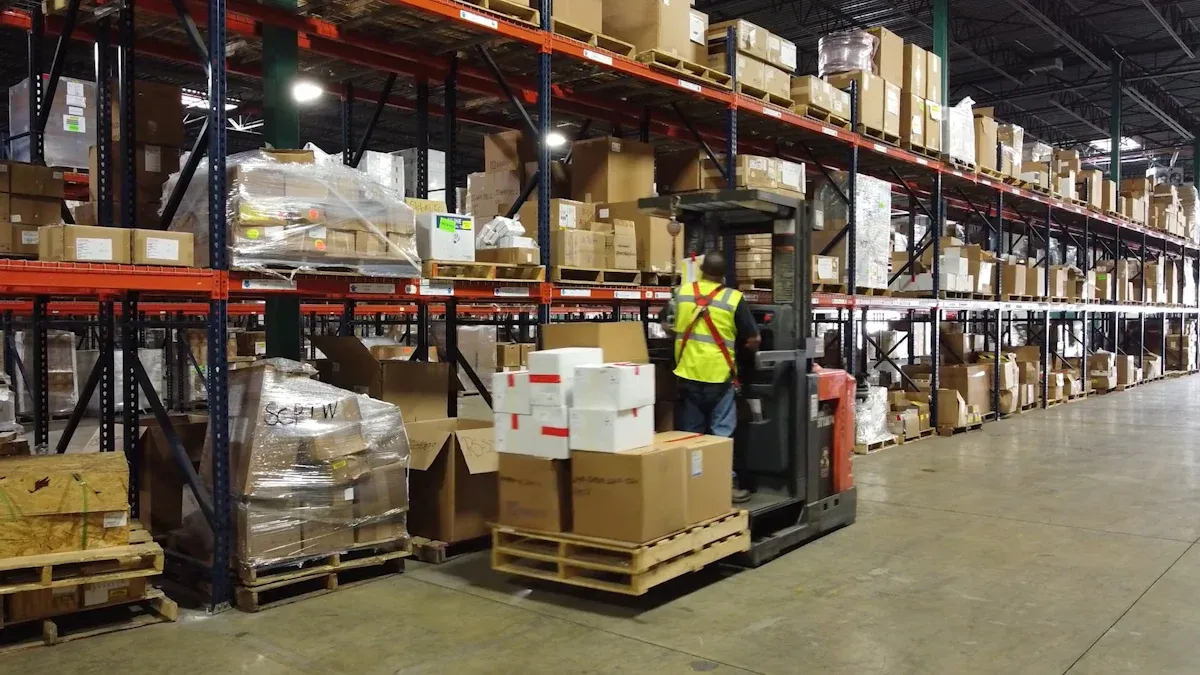Leverage Supply Chain Data to Reduce Risk and Improve Freight Performance

Supply chain data transforms the way you manage risks and optimize freight operations. It allows you to identify vulnerabilities and enhance efficiency by making informed decisions. Recent studies show that supply-side risks can reduce operational performance by up to 13.1%, while infrastructure-related risks cause a 32.2% decline. By adopting data-driven strategies, you can mitigate these challenges and improve freight performance. Supply chain management tools, such as predictive analytics and real-time tracking, provide the transparency needed to boost resilience and achieve operational excellence.
Key Takeaways
Supply chain data shows risks and makes work smoother.
Live tracking helps see progress, avoid delays, and please customers.
Predictive tools help spot problems early for easier operations.
Using data tools saves money and uses resources wisely.
Teaching teams to read data helps them decide better.
Understanding Supply Chain Risks

Common Risks in Supply Chains
Supply chains face a variety of risks that can disrupt operations and impact performance. These risks stem from economic, social, political, regulatory, and environmental factors. Economic risks include market fluctuations, inflation, and exchange rate volatility. Social risks arise from societal changes that affect business operations. Political risks involve instability, government decisions, and geopolitical conflicts. Regulatory risks emerge from changes in laws and standards, while environmental risks are caused by natural disasters and climate change.
Understanding these risks helps you minimize risks and prepare for emerging opportunities.
Type of Risk | Description |
|---|---|
Economic Risks | Risks related to market fluctuations, financial crises, exchange rates, and inflation. |
Social Risks | Societal changes that can disrupt business operations. |
Political Risks | Risks from political instability, government decisions, and geopolitical conflicts. |
Regulatory Risks | Changes in laws and standards that impose additional constraints and costs. |
Environmental Risks | Risks from natural events like climate change and disasters that are beyond company control. |
Why Traditional Approaches Fall Short
Traditional supply chain management strategies often fail to address modern risks effectively. Many businesses struggle to identify and manage risks due to limited resources and a lack of evidence-based knowledge. Inventory pre-positioning, a common strategy, incurs high costs and inefficiencies when managing disruption risks. Additionally, traditional approaches focus heavily on financial and operational risks, neglecting sustainability and corporate social responsibility, which are increasingly critical in risk assessment.
Businesses often lack optimal resources to identify and manage risks.
Inventory pre-positioning leads to inefficiencies and high costs.
Sustainability and social responsibility are overlooked in traditional risk management.
Adopting modern, data-driven strategies can help you overcome these limitations and build a resilient supply chain.
The Role of Supply Chain Data in Risk Reduction
Enhancing Visibility and Transparency
Supply chain data plays a pivotal role in improving visibility and transparency across your operations. By leveraging real-time monitoring systems, you can track performance and receive immediate alerts about potential risks or disruptions. For instance:
IoT devices and sensors collect real-time data, offering you a clearer view of your supply chain.
Big Data analytics processes vast amounts of information, enabling accurate forecasts and optimized inventory levels.
A proof of concept (PoC) demonstrated the value of trust-based data-sharing by allowing prime contractors to upload data from tier-2 suppliers. This approach enhances transparency across multiple supply chain layers, helping you improve supply chain visibility and anticipate future events. With these tools, you gain the strategic insights needed to address vulnerabilities before they escalate.
Tip: Implementing IoT and Big Data solutions can transform your supply chain into a transparent and efficient network.
Proactive Risk Identification and Mitigation
Supply chain data empowers you to identify risks proactively and develop effective mitigation strategies. Expert analyses highlight the importance of systematically assessing potential risks to maintain continuity in a complex global market. By using advanced tools like predictive analytics and AI, you can uncover hidden vulnerabilities and take action before disruptions occur.
Here’s how supply chain data supports proactive risk management:
Factor analysis reveals risks related to transportation delays and customs regulations.
Predictive tools analyze large datasets to uncover patterns and provide actionable insights.
AI-driven systems prioritize risks, enabling you to focus on the most critical issues.
This proactive approach ensures that your supply chain remains resilient, even in the face of unexpected challenges. By integrating these technologies, you can anticipate future events and safeguard your operations against costly disruptions.
Note: Businesses that adopt proactive risk management strategies often experience fewer delays and reduced operational costs.
Data-Driven Decision-Making for Resilience
Supply chain data enhances your decision-making by providing you with strategic insights that drive resilience. When you rely on data-driven insights, you can make informed choices that align with your business goals. For example, analyzing historical data helps you identify trends and adjust your operations accordingly.
Here are some ways supply chain data supports enhanced decision-making:
It enables you to optimize inventory levels, reducing waste and improving efficiency.
It provides real-time updates, allowing you to respond quickly to changes in demand or supply.
It helps you evaluate supplier performance, ensuring that you work with reliable partners.
By leveraging supply chain data, you can build a robust framework for decision-making that not only addresses current challenges but also prepares you for future uncertainties. This approach ensures that your supply chain remains agile and competitive in a rapidly changing market.
Callout: Data-driven decision-making is the cornerstone of a resilient and efficient supply chain.
Improving Freight Performance with Supply Chain Data

Route Optimization for Cost and Time Savings
Supply chain data enables you to optimize delivery routes, saving both time and money. By analyzing historical and real-time data, you can identify inefficiencies in your transportation network and adjust routes to reduce cycle times. Companies like UPS have demonstrated the power of route optimization. Their data-driven approach has saved approximately 1.6 million gallons of gasoline annually, significantly cutting costs and improving operational efficiency.
Amazon has also revolutionized delivery logistics by leveraging supply chain data. Their optimized routes ensure rapid delivery times and precise tracking, enhancing customer satisfaction. In postal logistics, predictive analytics has proven effective in managing disruptions. Historical data helps assess route performance, while real-time solutions address unexpected challenges.
Tip: Use advanced analytics tools to optimize performance and streamline your freight operations.
Predictive Maintenance to Prevent Downtime
Predictive maintenance uses supply chain data to monitor equipment health and prevent costly downtime. By analyzing patterns and anomalies, you can address issues before they escalate. This approach not only boosts uptime but also reduces maintenance costs. Deloitte’s studies show that predictive maintenance can improve uptime by 10-20% and lower maintenance expenses by up to 25%.
Benefit Type | Insight |
|---|---|
Uptime Improvement | Predictive maintenance increases equipment availability by 10-20%. |
Cost Reduction | Maintenance costs drop by up to 25%. |
Emergency Repair Avoidance | Prevents unexpected repair costs and extends equipment lifespan. |
Stricter workplace safety standards and the availability of AI tools make predictive maintenance more accessible than ever. By integrating these technologies, you can optimize processes and ensure uninterrupted freight operations.
Callout: Predictive maintenance is a proactive strategy that safeguards your equipment and enhances operational efficiency.
Real-Time Tracking for Enhanced Efficiency
Real-time visibility transforms freight operations by providing accurate and timely updates. Tracking systems allow you to monitor shipments, reduce dwell time, and streamline communications. This ensures freight reaches the correct destination while minimizing human error.
Real-time tracking also reduces manual communications, enabling faster decision-making. For example, sensors and IoT devices provide continuous updates, helping you optimize processes and improve performance. By reducing idle time at docks, you can enhance operational efficiency and reduce cycle times.
Note: Real-time tracking is essential for maintaining efficiency and ensuring smooth freight movement.
Demand Forecasting to Align Freight Operations
Demand forecasting helps you align freight operations with market needs. By predicting future demand, you can optimize resources, reduce waste, and improve delivery efficiency. Accurate forecasts ensure that your freight operations remain agile and responsive to changing customer expectations.
Why Demand Forecasting Matters
Demand forecasting minimizes the risks of overstocking or understocking inventory. It allows you to plan transportation schedules and allocate resources effectively. When you anticipate demand accurately, you avoid delays and reduce operational costs. For example, forecasting seasonal trends ensures that you prepare for peak periods without overburdening your supply chain.
Tip: Use demand forecasting to balance supply and demand, ensuring smooth freight operations during high-demand seasons.
Methods for Effective Demand Forecasting
Several forecasting methods help you predict demand accurately. Each method offers unique advantages depending on your data availability and business needs.
Forecasting Method | Description |
|---|---|
Qualitative Forecasting | Relies on expert opinions and market research, ideal for limited historical data. |
Time Series Analysis | Identifies patterns and trends using historical data, effective for seasonal demand. |
Causal Inferences | Establishes cause-and-effect relationships between demand and influencing factors. |
Machine Learning and Predictive Analytics | Analyzes large datasets to identify complex patterns and make predictions. |
CPFR | Involves collaboration among supply chain partners to enhance forecast accuracy. |
Delphi Method | Gathers expert opinions through rounds of feedback for informed predictions. |
Simulation Models | Creates virtual scenarios to assess the impact of various factors on demand. |
Machine learning and predictive analytics stand out for their ability to process large datasets and uncover hidden patterns. These tools enable you to make precise predictions, even in complex supply chain environments. Collaborative Planning, Forecasting, and Replenishment (CPFR) enhances accuracy by involving supply chain partners in the forecasting process.
Benefits of Demand Forecasting
Demand forecasting improves freight operations in several ways:
Optimized Resource Allocation: Accurate predictions help you allocate trucks, drivers, and warehouse space efficiently.
Reduced Costs: Forecasting prevents unnecessary shipments and reduces fuel consumption.
Improved Customer Satisfaction: Timely deliveries enhance customer trust and loyalty.
Enhanced Agility: Forecasting allows you to adapt quickly to market changes and unexpected disruptions.
For instance, simulation models create virtual scenarios to test different strategies. These models help you evaluate the impact of external factors like weather or geopolitical events on freight demand.
Callout: Businesses that use demand forecasting often experience smoother operations and higher profitability.
How JusLink Supports Demand Forecasting
JusLink’s AI-driven sales forecasting tools simplify the process of predicting demand. The platform uses deep learning algorithms to analyze market trends and adjust inventory levels dynamically. Its intelligent replenishment management ensures that your freight operations align with real-time demand. JusLink also integrates external data sources to provide a comprehensive view of market conditions, enabling you to make informed decisions.
By leveraging JusLink, you gain access to advanced forecasting capabilities that reduce risks and improve operational efficiency. The platform’s ability to predict demand accurately ensures that your freight operations remain competitive in a rapidly changing market.
Note: JusLink’s intelligent forecasting tools empower you to stay ahead of demand fluctuations and optimize your supply chain.
Key Tools and Technologies for Leveraging Supply Chain Data
Predictive Analytics and Machine Learning
Predictive analytics and machine learning transform how you manage supply chains. These tools analyze historical and real-time data to forecast trends, identify risks, and optimize operations. For example, predictive analytics helps you anticipate demand fluctuations, enabling better inventory management. Machine learning enhances this process by uncovering patterns in large datasets, which traditional methods might miss.
A comparative study highlights three key characteristics that make these technologies effective:
Characteristic | Description |
|---|---|
Volume | Larger data sets increase statistical reliability. |
Velocity | Rapid data generation from various sources ensures timely insights. |
Variety | Different types of data enhance predictive capabilities. |
By leveraging these tools, you can make informed decisions that improve efficiency and reduce risks. Predictive analytics also supports sustainability by helping you align operations with market demands, minimizing waste and overproduction.
Tip: Use predictive analytics to stay ahead of market trends and maintain a competitive edge.
Internet of Things (IoT) for Real-Time Monitoring
The Internet of Things (IoT) revolutionizes supply chain management by providing real-time monitoring capabilities. IoT devices, such as sensors and GPS trackers, collect and share data across your supply chain. This allows you to track shipments, monitor equipment health, and ensure timely deliveries.
Studies show that IoT enablers improve value chains by facilitating real-time data sharing. They also play a crucial role in meeting customer demands in dynamic markets. For instance, IoT frameworks assess supply chain readiness for Industry 4.0 transformations, ensuring your operations remain future-proof.
Aspect | Findings |
|---|---|
IoT Enablers | Assist businesses in improving their value chain through real-time data sharing. |
Sustainability | Essential for meeting aggressive customer requirements in a dynamic market. |
Framework | Proposed for assessing supply chain readiness for Industry 4.0 transformation. |
IoT not only enhances transparency but also reduces delays and inefficiencies. By integrating IoT into your operations, you can achieve seamless coordination and improved performance.
Callout: IoT ensures real-time visibility, helping you respond quickly to supply chain disruptions.
Enterprise Resource Planning (ERP) Systems
Enterprise Resource Planning (ERP) systems serve as the backbone of modern supply chain management. These systems integrate various functions, such as procurement, inventory, and logistics, into a unified platform. This integration provides you with a comprehensive view of your operations, enabling better coordination and decision-making.
ERP systems also leverage big data to enhance supply chain performance. They process vast amounts of information to identify inefficiencies and recommend improvements. For example, ERP platforms analyze supplier performance, helping you choose reliable partners. They also streamline workflows, reducing manual tasks and improving productivity.
Aspect | Findings |
|---|---|
BDA Applications | Applied across various SCM areas. |
Analytics Levels | Different levels of analytics utilized. |
Techniques | Various BDA techniques employed in SCM. |
By adopting ERP systems, you can align your supply chain processes with business goals. These systems ensure that your operations remain agile and responsive to market changes.
Note: ERP systems provide the foundation for data-driven supply chain management, ensuring long-term success.
JusLink Intelligent Supply Chain Platform
JusLink stands out as a game-changer in supply chain management. It combines advanced technologies like AI, IoT, and big data to create a seamless and intelligent platform. This tool empowers you to manage your supply chain with precision and efficiency.
Key Features of JusLink
JusLink offers a range of features designed to simplify complex supply chain operations:
AI-Driven Sales Forecasting: Predict market trends and adjust inventory levels dynamically.
Intelligent Risk Management: Monitor risks in real time and receive timely alerts.
Smart Replenishment: Ensure optimal stock levels by automating inventory adjustments.
Automated Application Management: Track shipments and detect anomalies effortlessly.
These features provide you with the tools needed to stay ahead in a competitive market.
How JusLink Benefits Your Supply Chain
JusLink delivers measurable benefits that enhance your supply chain performance:
Benefit | Description |
|---|---|
Enhanced Visibility | Real-time data sharing ensures transparency across all supply chain layers. |
Risk Reduction | Proactive monitoring minimizes disruptions and delays. |
Cost Optimization | AI tools reduce waste and improve resource allocation. |
Improved Decision-Making | Data-driven insights help you make smarter, faster choices. |
Tip: Use JusLink to gain complete control over your supply chain and reduce inefficiencies.
Why Choose JusLink?
JusLink’s microservices architecture allows you to customize its features based on your business needs. It supports end-to-end visibility, enabling you to monitor every stage of your supply chain. The platform’s ability to integrate with existing systems like ERP and TMS ensures a smooth transition.
By adopting JusLink, you can transform your supply chain into a resilient and agile network. This platform equips you with the tools to adapt to market changes and maintain a competitive edge.
Callout: JusLink is your partner in building a smarter, more efficient supply chain.
Case Studies: Real-World Success Stories
SHARP: Reducing Risk with Predictive Analytics
SHARP, a global leader in household appliances, faced challenges in managing its complex supply chain. Frequent disruptions led to increased costs and delayed deliveries. By adopting predictive analytics, Sharp transformed its operations. The company used data-driven insights to forecast demand, identify potential risks, and optimize inventory levels.
Predictive analytics allowed Sharp to:
Anticipate supply chain disruptions and take preventive measures.
Reduce logistics costs by 20%.
Improve order processing cycles, ensuring timely deliveries.
Tip: Predictive analytics helps you stay ahead of risks and maintain smooth operations.
SHARP’s success demonstrates how data-driven tools can enhance supply chain resilience and efficiency.
JUSDA: Optimizing Freight Performance with IoT and JusLink
JUSDA leveraged its JusLink Intelligent Supply Chain Platform to address the growing complexity of global logistics. By integrating IoT devices and real-time monitoring, JUSDA improved freight performance across multiple industries. JusLink’s features, such as smart replenishment and automated tracking, enabled seamless coordination.
Key outcomes included:
Enhanced visibility across all supply chain layers.
Reduced delays through real-time tracking and anomaly detection.
Improved resource allocation, cutting operational costs significantly.
Callout: JusLink’s IoT integration ensures you can monitor shipments and respond to disruptions instantly.
JUSDA’s innovative approach highlights the power of combining IoT and intelligent platforms to optimize freight operations.
Global Manufacturer: Leveraging ERP for End-to-End Visibility
A leading global manufacturer struggled with fragmented supply chain processes. The lack of integration between procurement, inventory, and logistics systems caused inefficiencies. By implementing an ERP system, the company achieved end-to-end visibility and streamlined operations.
The ERP system provided:
A unified platform for real-time data sharing.
Improved supplier performance tracking.
Enhanced decision-making through actionable insights.
Note: ERP systems help you align supply chain processes with business goals for maximum efficiency.
This case study underscores the importance of ERP systems in creating a cohesive and agile supply chain.

After the update
Supply Chain Management Solution
Supply chain data transforms how you manage risks and improve freight performance. It optimizes processes, enhances visibility, and provides predictive insights that strengthen your operations.
Data analytics identifies inefficiencies, saving costs and boosting efficiency.
Real-time tracking improves customer satisfaction and decision-making.
Predictive tools anticipate disruptions, ensuring reliability.
Strategic insights guide long-term planning.
"To improve performance, you must measure current levels and identify areas for growth, focusing on efficiency, customer satisfaction, and business success."
Adopting tools like JusLink ensures you stay competitive. Continuous innovation and collaboration will future-proof your supply chain.
FAQ
What is supply chain data, and why is it important?
Supply chain data includes information about inventory, transportation, suppliers, and customer demand. It helps you make better decisions, reduce risks, and improve efficiency. By analyzing this data, you can optimize operations and respond quickly to changes in the market.
How does JusLink improve supply chain performance?
JusLink uses AI, IoT, and big data to provide real-time tracking, demand forecasting, and risk management. It helps you monitor shipments, predict market trends, and automate processes. These features ensure your supply chain stays efficient and competitive.
Can small businesses benefit from supply chain data?
Yes, small businesses can use supply chain data to optimize inventory, reduce costs, and improve delivery times. Tools like JusLink offer scalable solutions, making it easier for smaller companies to adopt data-driven strategies without overwhelming resources.
What technologies are essential for modern supply chain management?
Key technologies include predictive analytics, IoT devices, and ERP systems. Predictive analytics forecasts trends, IoT provides real-time monitoring, and ERP integrates operations. Together, these tools help you streamline processes and enhance decision-making.
How can I start using supply chain data in my business?
Begin by identifying areas where data can improve efficiency, like inventory or transportation. Use tools like JusLink to collect and analyze data. Start small with a pilot program, measure results, and gradually expand to other parts of your supply chain.
Tip: Focus on one high-impact area first, such as reducing delivery delays or optimizing inventory.
See Also
Streamlining Supply Chains Through Effective Risk Management Strategies
Understanding Current Trends in Logistics Risk Management
Revealing Big Data's Role in Strengthening Supply Chains
Transforming Supply Chain Management Using Big Data Analytics
Expert Strategies for Effective Risk Management in Supply Chains
